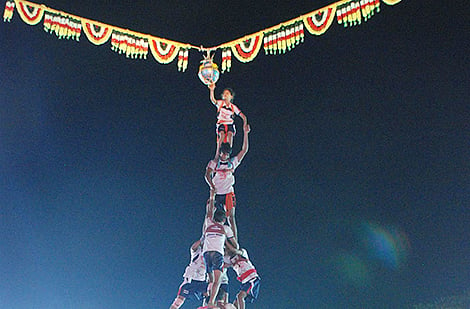Every woman takes pride in fasting in the month of Shravan for peace and prosperity of her family, write MEERA S. SASHITAL.
The month of Shravan is extremely auspicious for the Hindus. It is an important month of the ‘Chaturmas’ as this holy month (corresponding to July-August) is punctuated by innumerable festivals like Nag Panchami, Varalakshmi, Raksha Bandhan and Narali Purnima, Povati Purnima and Gokulashtami. But, there is yet another religious ceremony prevalent amongst Chitrapur Saraswat and Gaud Saraswat Brahmins of the South, called the ‘Chudi’ Puja. Actually, according to history the community of Saraswat Brahmins hail from Kashmir and traced to Saraswati River, but who had to migrate to South during foreign invasions.
The Chudi puja is entirely restricted to married women though young unmarried girls also enthusiastically take part in it. No sooner the Shravan month commences married women, look forward to Fridays and Sundays to worship the sacred Tulsi Plant (Ocimum Sanctum). Women eagerly flock round the Tulsi Plant to worship it by offering the Chudis which are tiny bouquets of flowers. The importance of the puja lies in the Chudis which is the prime item without which the puja has no beauty. The name ‘Chudi puja’ itself implies its meaning.
From the early hours of the mornings of every Friday and Sunday in Shravan, the subtle fingers of the womenfolk are busy making tiny bouquets or Chudis (as they are called in Konkani). These tiny bouquets are made from the myriad of coloured flowers that bloom during monsoon. The improvisation of different colour schemes, combined with artistic ingenuity, add a magic glow to the otherwise naïve flowers. But hold on! No Chudi or the tiny bouquet is regarded complete without the blades of green ‘Durva’ grass (Cynodon dactyion) which strikingly enhance the beauty of the Chudis or bouquets.
Minimum five Chudis are required for the puja and these are elegantly arranged in a tray with some loose flowers too. In the tray all the items necessary for puja like vermillion, haldi, incense, grains of rice, betel leaves and nuts, fruits, a bowl of water and sweet, of course, are arranged with the Chudis and placed before the Tulsi plant for offering. Tray thus ceremonially arranged needless to say looks highly equisite.
Prior to the Puja, the doorsteps of the house are wiped and decorated with designs from stones of lime or chalk. All essential things like rice containers, the buttermilk churning pole, treasury chests are shaded with chalk. The retinue of women followed by young girls, carry the tray with the Puja items to the Tulsi plant. On a small wooden board or if not on the floor a symbolic diagram is drawn with chalk on which the offerings are made to the Tulsi plant.
The short ceremony commences with application of vermillion and haldi to the Tulsi plant, the wooden board and also the bowl of water which is said to represent the Holy Ganges. Then all the five Chudis or bouquet of flowers are rinsed with the holy water after taking a sip, and together with betel leaf and nut are offered to the Tulsi plant. Fruits and sweets are also offered and the lighted incense waved before the Tulsi plant. As in every religious ceremony rice plays an prominent role, so grains of rice are showered on the Tulsi plant and also up towards the Sun to revere Him as well. Next performance is to do the circumambulation of the Tulsi plant by the ladies and prostrate.
The main peculiarity lies in the grandeur of the Tulsi plant, as specially for this ceremony the green blooming holy Tulsi bedecked with multi-coloured pretty little bouquets looks gorgeous. In fact it is a sight to behold the Tulsi spotted with fusion of spectacular Chudis.
After the ceremony, flowers or petals are placed on either side of the threshold on the doorways and applied with vermillion and Haldi. Similarly, all the items shaded white look bright with the smeared red vermillion. The function finally gets over with the offering of ‘Chudis’ with the betel leaf and nut and Haldi-Kumkum to atleast five elderly married ladies and seeking their blessings and the exchange of the same between the younger ladies. On this auspicious occasion, usually the first offering of the ‘Chudi’ by the newly wedded bride or girl to her elders is rewarded with gifts in kind or cash.
This custom of worshipping the Tulsi plant, especially during the Shravan month may prevail among other communities too but, the system of “chudis” may be said to belong exclusively to the Konkani speaking Saraswat Brahmins. All Mondays in the month of Shravan are looked upon as holy and fasts. Mondays of other months are barely so honoured.
Every woman takes pride in fasting in the month of Shravan for peace and prosperity of her family. Every married woman who performs this Chudi Puja of the Tulsi plant prays that she may be able to continue this during her lifetime with happiness. The ceremony, though not elaborate in itself, reflects the intricate blending of art, culture and aesthetics with religion and spirituality of the community.
In the present times when most of the women are working it is surely difficult to snatch time to do these Pujas etc. But yet I am proud that despite the short of time they manage to do the Tulsi puja even be it fast.






